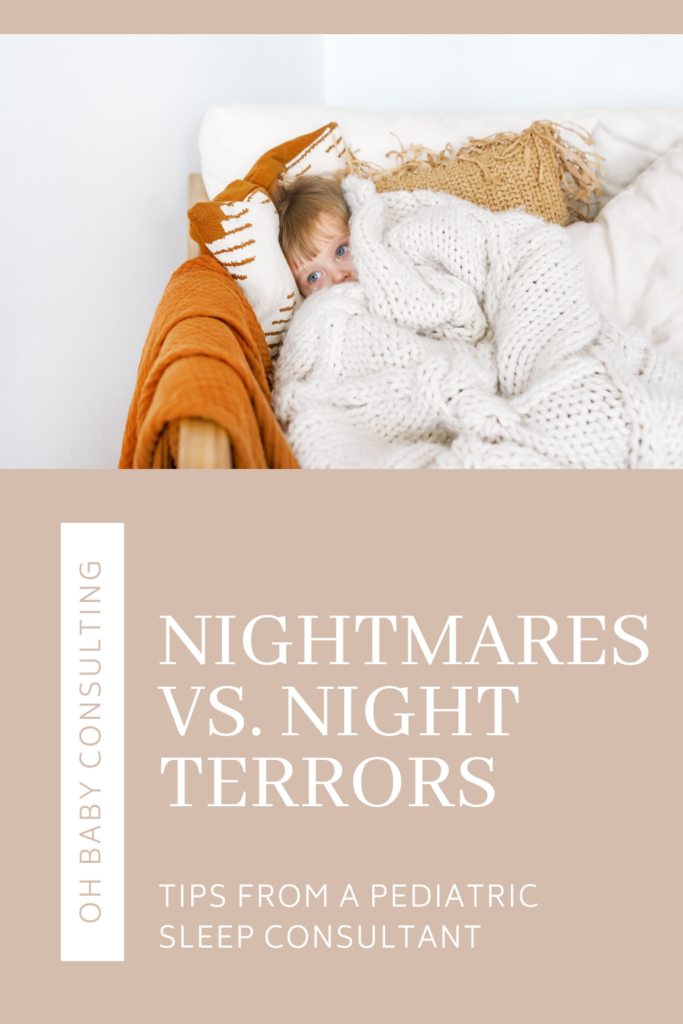Nightmares and night terrors are a normal (though icky) part of the childhood experience. But most of the time, they are more frightening for the parent than they are for the child. There is truly nothing worse than being awoken by the sound of a terrified scream coming from your child’s bedroom.
But are nightmares and night terrors the same thing? How can you differentiate between nightmares vs. night terrors? Knowing the difference between these two phenomena is key to determining just how to handle them (and how to prevent them, too!)
Nightmares
Nightmares are fairly common in children ages 2-4 and though they are scary, they’re also a very normal part of development. They often stem from hearing a scary story or watching something graphic or frightening on TV. During toddlerhood, imaginations are expanding and normal fears begin to develop. Toddlers and preschoolers have difficulty distinguishing between fantasy and reality making innocuous things seem terrifyingly real. Additionally, normal childhood experiences occurring around this time can cause extra stress which also can trigger nightmares. Things like moving into a big-kid bed, potty training, starting preschool, or even getting a new sibling can all trigger bad dreams.
As children age and become more cognitively mature, their grasp on reality becomes firmer but their exposure to and comprehension of real-life dangers also increases. You may see your 5-8 year old plagued with nightmares about natural disasters, robbers, or losing a parent – phenomena much more sophistocated than monsters in the closet.
Nightmares occur during REM sleep – the end-stage of one complete sleep cycle – and typically occur during the second half of the night. If your child has a nightmare, they will usually wake and seek out comfort for their disturbing dream. They may even be able to verbalize what frightened them in that moment. After waking from a nightmare, it could take children a while to fall back to sleep and rid their mind of the scary thoughts that felt so incredibly real.
REDUCING NIGHTMARES
While nightmares may be inevitable from time to time, here are some things you can do to help reduce their frequency:
- Say no to the super scary stuff. Avoid exposure to scary or overstimulating movies, TV shows, video games, books, or play. This is especially important in the hours leading up to bedtime.
- Have a relaxing and predictable bedtime routine that does not include any screen-time.
- Embrace an early bedtime. Overtiredness and sleep deprivation can cause nightmares.
- Reduce daily stressors. Recurring nightmares can be an indication of stress. Help your child practice deep breathing and relaxation exercises throughout the day and incorporate calming activities into the bedtime routine.
- If your child is afraid of the dark, use a small nightlight situated behind a piece of furniture to limit direct exposure. Use a light that glows a soft yellow, amber, or red instead of one that is white or blue.
- Check with your child’s pediatrician to make sure your child is not on any medications that may be interfering with quality nighttime sleep or can cause nightmares.
HANDLING NIGHTMARES
If your child wakes from the occasional nightmare, respond right away. Help your child to calm down and allow them to talk about their dream if they want. Avoid asking leading questions that may exaccerbate or reintroduce a new fear. You can reassure your child that it was only a dream, but remember that this dream likely felt very real to your little one so try not to disregard their scared feelings.
That being said, there is a fine line between being supportive and buying into/affirming a child’s fears – especially fantastical ones. It is important to avoid unintentionally perpetuating their fear by using things like monster spray, checking under the bed for monsters (basically confirming that monsters are real) and even going so far as to never letting your child sleep alone which can impact their confidence and make them feel unsafe when they’re not with you. Remind your child that it is your job to make sure they are safe while sleeping, and leave them feeling calm and confident, even if you have to help them settle back to sleep.
If the fears persist night after night and the request for your presence while falling asleep or in the middle of the night become the norm, having a plan of action that validates your child’s anxieties but empowers their realities is super important.
INSTEAD OF: “You don’t have to sleep in your room. Come sleep in my bed” [can become rewarding] or, “I’ll stay here to make sure there are no monsters.” [implies monsters are real]
TRY: “That must have been a scary dream. It’s okay to feel scared but I won’t let anything happen to you. My job is to keep you safe! Let’s think of something happy and I’ll stay here for a few minutes to help you relax. I’ll give you kisses before I go back to bed.”
Reminder: out-of-the-norm anxieties & fears should always be brought to the attention of a medical professional/clinician.
Night Terrors
Night terrors are categorically different from nightmares in both causes and experience. While nightmares occur during REM sleep, night terrors happen during non-REM sleep and usually happen within 2-3 hours after bedtime. Night terrors are not bad dreams, and children typically have no recollection of this event the next morning. Regardless, night terrors can be absolutely terrifying for you as the parent.
If your child is experiencing a night terror, they might scream inconsolably, become drenched in sweat, and may not even respond or calm when you go to comfort them. Night terror episodes typically last between 5-15 minutes before your child calms down enough to fall back to sleep, but because this event occurs during non-REM sleep, they are actually not dreaming at all.
Night terrors are most common in boys between the ages of 2-5 and do have a hereditary component. Sometimes they occur during developmental leaps, but the most common cause of night terrors is sleep deprivation or a disturbance to your child’s typical sleep patterns such as overtiredness, traveling across time zones, or going to bed very late.
REDUCING NIGHT TERRORS
If your child is frequently experiencing night terrors, it may be a good idea to bring it up to your pediatrician. In the meantime, here are things you can do to reduce/eliminate episodes:
- Put your child to bed earlier. Bedtime during childhood should be between 6:00-8:00 p.m.
- Ensure your child is getting the recommended amount of sleep for their age, and keep a consistent sleep schedule for your child.
HANDLING NIGHT TERRORS
If your child is experiencing a night terror, here are some in-the-moment strategies you can use:
- If your child is in the midst of a night terror episode, monitor your child for safety but try not to interfere as this can worsen the situation. It is best not to wake your child and, instead, guide them back to sleep as they start to calm down.
- Make sure your child is physically safe in their bedroom. You might have to put a gate at the top of the stairs, add low lighting in the hallway, remove clutter that they could trip over, or bolt down any bedroom furniture.
- Don’t try to talk about the episode during the night or the next day. This could frighten your child and lead to stress at bedtime. Remember, they likely don’t have any memory of the episode.
FOR FREQUENT NIGHT TERRORS
If night terrors are common and consistently happening each night:
- Keep a sleep log to chart your child’s sleep patterns for at least 1 week.
- Ensure your child is meeting their minimum sleep needs.
- Gently rouse your child 15 minutes prior to the time they usually have an episode.
- Do this every night for 7-10 nights in a row.
- Speak with your pediatrician to rule out any medical sleep disturbances.
Knowing how to differentiate between nightmares and night terrors is important to determine the best course of action for handling them and to make sure everyone sleeps peacefully.
If you’re concerned that your infant (under 18-24 months) is having nightmares, chances are they are not. Their fragmented nights and upset cries are likely a result of being awake when they don’t want to be. If you’d like some support in getting sleep on a better path, please reach out & let’s work together to keep everyone sleeping peacefully.














